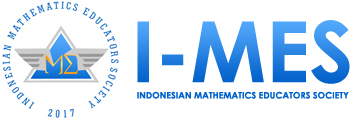Peningkatan Kemampuan Berpikir Kreatif dengan Konteks Budaya Lokal Karawang Menggunakan Realistic Mathematics Education Pada Masa Pandemi
DOI:
https://doi.org/10.35706/sjme.v6i1.5761Abstract
Creative thinking can be said to construct an idea that emphasizes several aspects of ability, such as flexibility and originality. This can familiarize students not only with knowing the material but also understanding and applying it in everyday life so that understanding becomes long-term memory in memory. This creative thinking ability can be facilitated during the learning process in a mathematically realistic approach or better known as RME. So the purpose of this research is to improve students' creative abilities through a mathematical realistic approach with local culture as a context. This study uses a quasi-experimental method with a research design of The Nonequivalent Control Group Design through a creative thinking test. The study was conducted in two classes with different treatments, one class as the experimental class and the other as the control class. Conducted at the seventh grade junior high school level. The results of this study are the improvement of students' mathematical creative thinking skills who receive RME learning is better than students who receive expository learning methods.
Downloads
References
Alexander, K. D. (2007). Effects Instruction in Creative Problem Solving on Cognition, Creativity, and Satisfaction Among Ninth Grade Students in an Introduction to World Agricultural Science and Technology Course. 1–246. https://ttu-ir.tdl.org/handle/2346/18066
Ardiyanti, Y. (2014). Penggunaan Lembar Kerja (Lk) Terbuka Untuk Peningkatan Pemahaman Konsep Dan Berpikir Kreatif Pada Mata Kuliah Biologi Umum. Jurnal Ilmiah Solusi, 1(1), 18–21.
Arsana, I. K., Suarjana, M., & Arini, N. W. (2019). Pengaruh Penggunaan Mind Mapping berbantuan Alat Peraga Tangga Garis Bilangan terhadap Hasil Belajar Matematika. International Journal of Elementary Education, 3(2), 99. https://doi.org/10.23887/ijee.v3i2.18511
Cahya Sari Putra, E., & Nur Mahmudah, F. (2021). The Implementation of Ethnomathematics Based-Learning for Students. SJME (Supremum Journal of Mathematics Education), 5(2), 162–169. https://doi.org/10.35706/sjme.v5i2.4827
Creswell, J. W. (2012). Educational Research: Planning, Conducting and Evaluating Quantitative and Qualitative Research (Matthew Buchholtz (ed.); Fourth). Pearson Education, Inc.
Dewi Wahyuni, Rubhan Masykur, D. D. P. (2019). Pengembangan Multimedia Pembelajaran Matematika dengan Pendekatan Matematika Realistik. AKSIOMA: Jurnal Program Studi Pendidikan Matematika, 8(1), 32–40. https://doi.org/10.24127/ajpm.v8i1.1711
Febrian, D. W. (2013). Pembelajaran Tgt Melalui Pendekatan Pmri Berbantuan Permainan Tradisional Terhadap Kemampuan Berpikir Kreatif. Unnes Journal of Mathematics Education, 2(2). https://doi.org/10.15294/ujme.v2i2.3334
Handoko, H. (2017). Pembentukan Keterampilan Berpikir Kreatif Pada Pembelajaran Matematika Model Savi Berbasis Discovery Strategy Materi Dimensi Tiga Kelas X. Eduma : Mathematics Education Learning and Teaching, 6(1), 85–95. https://doi.org/10.24235/eduma.v6i1.1711
Haq, M. N. A. S. S.-R. R. (2012). A Comparison of Creative Thinking Abilities of High and Low Achievers Secondary School Students. International Interdisciplinary Journal of Education, 1(1), 1–6.
Hidayat, E. I. F., Vivi Yandhari, I. A., & Alamsyah, T. P. (2020). Efektivitas Pendekatan Realistic Mathematics Education (RME) Untuk Meningkatkan Kemampuan Pemahaman Konsep Matematika Siswa Kelas V. Jurnal Ilmiah Sekolah Dasar, 4(1), 106. https://doi.org/10.23887/jisd.v4i1.21103
Idrus Hariri, A., & Mulyani, A. (2016). Penerapan Pembelajaran Berbasis Sains Budaya Lokal Ngaseup Pada Konsep Sistem Reproduksi Manusia Untuk Meningkatkan Keterampilan Berpikir Kritis Siswa Kelas Xi Sman 1 Maja. Scientiae Educatia: Jurnal Sains Dan Pendidikan Sains, 5(1), 1–14. https://doi.org/10.24235/sc.educatia.v5i1.961
Kanda S, A. S. (2020). Mengembangkan Kemampuan Pemahaman Dan Bepfikir Kreatif Matematik Serta Motivasi Belajar Mahasiswa Melalui Penerapan Aplikasi Statistics Quick. SJME (Supremum Journal of Mathematics Education), 4(2), 188–196. https://doi.org/10.35706/sjme.v4i2.3648
Kasanah, S. A., Damayani, A. T., & Rofian, R. (2019). Keefektifan Model Pembelajaran Role Playing Berbantu Media Multiply Cards terhadap Hasil Belajar Siswa. Jurnal Ilmiah Sekolah Dasar, 3(4), 519–526. https://doi.org/10.23887/jisd.v3i4.22308
Khotimah, S. H., & As’ad, M. (2020). Pendekatan Pendidikan Matematika Realistik Terhadap Hasil Belajar Matematika Siswa Sekolah Dasar [Realistic Mathematics Education Approach to Mathematics Learning Outcomes for Elementary School Students]. Jurnal Imiah Pendidikan Dan Pembelajaran, 4(3), 491–498. https://doi.org/10.23887/jipp.v4i3.28568
Kuswana, W. S. (2013). Taksonomi Berpikir (A. Fauzia (ed.)). Remaja Rosdakarya.
Mahmudi, A. (2008). Tinjauan Kreativitas dalam Pembelajaran Matematika. Pythagoras: Jurnal Pendidikan Matematika, 4(2), 37–49. https://doi.org/10.21831/pg.v4i2.559
Mahmudi, A. (2010). Mengukur Kemampuan Berpikir Kreatif Matematis, Makalah dipersentasikan. In Konferensi Nasional Matematika XV. UNIMA.
Mann, E. L. (2005). Mathematical creativity and school mathematics: Indicators of mathematical creativity in middle school students 1956. Dissertation Abstracts International Section A: Humanities and Social Sciences, 67, 461.
Matlin, M. W. (2009). Cognition (7th ed.). John Wiley & Sons, Inc.
Moma, L. (2015). Pengembangan Instrumen Kemampuan Berpikir Kreatif Matematis Untuk Siswa Smp. Delta-Pi: Jurnal Matematika Dan Pendidikan Matematika, 4(1), 27–41. https://doi.org/10.33387/dpi.v4i1.142
Mulyati, T. (2016). Pendekatan Konstruktivisme Dan Dampaknnya Bagi Hasil Belajar Matematika Siswa SD. EduHumaniora | Jurnal Pendidikan Dasar Kampus Cibiru, 1(2). https://doi.org/10.17509/eh.v1i2.2738
Munandar, U. (2009). Pengembangan Kreativitas Anak Berbakat. Rineka Cipta.
Nurina Hidayah, Nining Choiriyanisa, D. S. (2018). Pendekatan Matematika Realistik Indonesia. Prosiding Seminar Nasional Universitas Pekalongan, 165–178.
PARK, H. (2004). The Effects of Divergent Production Activities With Math Inquiry and Think Aloud of Students With Math Difficulty. CWL Publishing Enterprises, Inc., Madison, 2004(May), 352. http://onlinelibrary.wiley.com/doi/10.1002/cbdv.200490137/abstract
Rahmawati Suwanto, F., & Wijaya, A. (2021). The Enhancement of Students Mathematical Communication Ability Through RME-Textbook. SJME (Supremum Journal of Mathematics Education), 5(1), 43–52. https://doi.org/10.35706/sjme.v5i1.4412
Rudyanto, H. E. (2014). Model Discovery Learning Dengan Pendekatan Saintifik Bermuatan Karakter Untuk Meningkatkan Kemampuan Berpikir Kreatif. Premiere Educandum : Jurnal Pendidikan Dasar Dan Pembelajaran, 4(01), 41–48. https://doi.org/10.25273/pe.v4i01.305
Septiana, F., Mujib, M., & Negara, H. S. (2018). Penerapan Pendekatan Pendidikan Matematika Realistik Indonesia (PMRI) ditinjau dari Multiple Intelligences. Desimal: Jurnal Matematika, 1(1), 23–28. https://doi.org/10.24042/djm.v1i1.1932
Siregar, R. N., Mujib, A., Hasratuddin, & Karnasih, I. (2020). Peningkatan Kemampuan Berpikir Kreatif Siswa Melalui Pendekatan Matematika Realistik. Edumaspul Jurnal Pendidikan, 4(1), 56–62. https://doi.org/10.33487/edumaspul.v4i1.338
Sulastri, S., Marwan, M., & Duskri, M. (2017). Kemampuan Representasi Matematis Siswa SMP Melalui Pendekatan Pendidikan Matematika Realistik. Beta Jurnal Tadris Matematika, 10(1), 51–69. https://doi.org/10.20414/betajtm.v10i1.101
Utami, M. R., Ardiyanti, Y., & Ratnasari, D. (2020). Pengaruh Problem-Based Learning Terhadap Penguasaan Konsep Dan Keterampilan Berpikir. Satya Widya, 36(2), 81–87. https://doi.org/10.24246/j.sw.2020.v36.i2
Vivi Muliandari, P. T. (2019). Pengaruh Model Pembelajaran Kooperatif Tipe NHT (Numbered Head Together) Terhadap Hasil Belajar Matematika. International Journal of Elementary Education, 3(2), 132–140. https://doi.org/10.23887/ijee.v3i2.18517
Wibowo, A. (2017). Pengaruh pendekatan pembelajaran matematika realistik dan saintifik terhadap prestasi belajar, kemampuan penalaran matematis dan minat belajar. Jurnal Riset Pendidikan Matematika, 4(1), 1–10. https://doi.org/10.21831/jrpm.v4i1.10066
Widyastuti, N. S., & Pujiastuti, P. (2014). Pengaruh Pendidikan Matematika Realistik Indonesia (Pmri) Terhadap Pemahaman Konsep Dan Berpikir Logis Siswa. Jurnal Prima Edukasia, 2(2), 183–193. https://doi.org/10.21831/jpe.v2i2.2718
Yusmaniar, Y. (2017). Pendekatan Matematika Realistik Untuk Meningkatkan Hasil Belajar Siswa Kelas I Pada Operasi Hitung. JPPI (Jurnal Penelitian Pendidikan Indonesia), 3(1), 51. https://doi.org/10.29210/02017109
Downloads
Published
How to Cite
Issue
Section
License

This work is licensed under a Creative Commons Attribution-ShareAlike 4.0 International License.
Authors who publish with this journal agree to the following terms:
- Authors retain copyright and grant the journal right of first publication with the work simultaneously licensed under a Creative Commons Attribution License that allows others to share the work with an acknowledgment of the work's authorship and initial publication in this journal.
- Authors are able to enter into separate, additional contractual arrangements for the non-exclusive distribution of the journal's published version of the work (e.g., post it to an institutional repository or publish it in a book), with an acknowledgment of its initial publication in this journal.
- Authors are permitted and encouraged to post their work online (e.g., in institutional repositories or on their website) prior to and during the submission process, as it can lead to productive exchanges, as well as earlier and greater citation of published work (See The Effect of Open Access).











